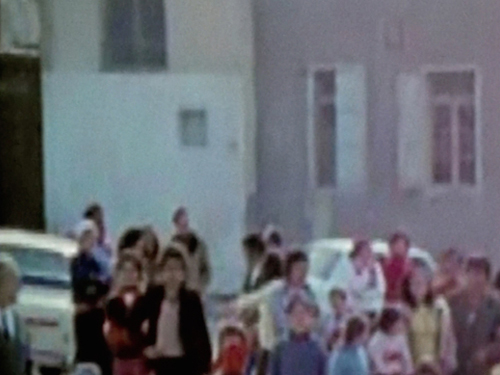
“Recollection utilizes footage from Israeli films as raw material for exploring, reconstructing, and sharing the inaccessible history of his hometown Jaffa: “For many years, I have been collecting Israeli fiction films shot in Jaffa as early as 1960. These are films in which Palestinians are disappeared, yet also exist at the edge of frames, visible in traces. Preserved also is a city; alive again in moving images, its gradual destruction over the decades chronicled film by film. From the footage of dozens of films I have excavated a whole community and recreated the city. Though out-of-focus, half-glimpsed, I have recognized childhood friends, old people I used to say good evening to as a boy; my uncle. I erased the actors, I photographed the backgrounds and the edges; and made the passersby the main characters of this film. In my film, I find my way from the sea, like in a dream. I walk everywhere, sometimes hesitant and sometimes lost. I wander through the city; I wander through the memories. I film everything I encounter because I know it no longer exists. I return to a lost time.”
Kamal Aljafari1
In Kamal Aljafari’s new film Recollection, freedom is experienced in ‘the sound of the ocean…the echo you can hear outside but recorded from inside the wall. Life buried beneath, inside the sea.’ As the images move slowly, other times brusquely, from a silhouette to a shadow, a sliver of the port city of Jaffa to another, the sound moves us into the present unearthing a past. We begin to see the ruins as breathing bodies. We see the place Palestinians have lived in and have been exiled from. And gradually we are brought face-to-face with history, with destruction. The phantoms stare at us. The filmmaker ‘frees the image,’ an act he calls ‘cinematic justice.’
Nathalie Handal2
“We can no longer stand this kind of ‘political’ fiction, because, as it happens, some filmmakers have started making political films that are based on the opposite idea. That is, based on a direct contact between real bodies and political words, statements, ideas, and ideals – without the mediation of a story, feelings, and so on. Think of the way in which Jean-Marie Straub and Danièle Huillet put the words of Vittorini or Pavese in the bodies of people who are, simultaneously, working ordinary jobs in a little village in Tuscany, and acting in local theatres. Straub and Huillet use this capacity of anybody to be an actor to create a direct relation between political statements and bodies. You can also think of what Jean-Luc Godard does with the traces of history, in front of the building that used to be a Renault factory, in Éloge de l’amour (2001). We can think of a multiplicity of films of that kind. Think of the work of Khalil Joreige and Joana Hadjithomas or Kamal Aljafari: their work deals with disappearance, it looks into how politics is inscribed in the landscape, in the presence or absence of traces. In that same article I deal with Lanzmann’s Shoah (1985), which takes the words of some witnesses and tries to stage the power of those words in the present, within certain landscapes. I think what has happened to the real doesn’t have to do with the loss of the artifice, the privilege of the visual, and all the rest of it. It has to do with the fact that we have been accustomed to seeing those films that try to deal directly with politics – in our bodies, in our faces, in our voices.”
Jacques Rancière3
Dit soort ‘politieke’ fictie kunnen we niet langer verdragen omdat sommige cineasten politieke films zijn beginnen te maken die gebaseerd zijn op het tegenovergestelde idee. Dat wil zeggen films gebaseerd op een direct contact tussen echte lichamen en politieke woorden, statements, ideeën en idealen; zonder de bemiddeling van een verhaal, gevoelens enzovoort. Denk aan de manier waarop Jean-Marie Straub en Danièle Huillet de woorden van Vittorini of Pavese in de lichamen leggen van mensen die een gewone baan hebben in een Toscaans dorpje en tegelijkertijd acteren in plaatselijke theaters. Straub en Huillet gebruiken eenieders capaciteit om een acteur te zijn om een directe relatie te creëren tussen politieke statements en lichamen. Denk ook aan wat Jean-Luc Godard doet met de sporen van de geschiedenis, tegenover het gebouw dat vroeger een Renaultfabriek was, in Éloge de l’amour (2001). Er is een veelvoud aan dergelijke films. Denk aan het werk van Khalil Joreige en Joana Hadjithomas of van Kamal Aljafari: hun werk gaat over verdwijning, het onderzoekt hoe politiek in het landschap is gegraveerd, met aanwezige of afwezige sporen. In datzelfde artikel behandel ik Claude Lanzmanns Shoah (1985), dat de woorden van getuigen opneemt en probeert de kracht van die woorden in het heden te plaatsen, in bepaalde landschappen. Ik denk dat wat er is gebeurd met het reële niet te maken heeft met het verlies van het artificiële, de dominantie van het visuele en dergelijke zaken. Wel heeft het te maken met het feit dat we gewend zijn geraakt aan het zien van films die proberen rechtstreeks met politiek om te gaan, in ons lichaam, in onze gezichten en in onze stemmen.
Jacques Rancière4
- 1Courtisane Festival 2017 program
- 2Nathalie Handal, “Kamal Aljafari: Unfinished Balconies in the Sea,” Guernica, 18 February 2016.
- 3Stoffel Debuysere, “On the Borders of Fiction. A Conversation with Jacques Rancière,” Sabzian, 20 September 2017.
- 4Stoffel Debuysere, “Over de grenzen van fictie. Een gesprek met Jacques Rancière,” Sabzian, 9 januari 2019.

